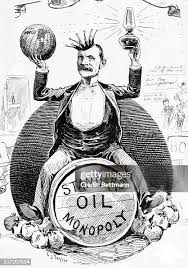🏛️ From Dominance to Detest
By the dawn of the 20th century, Standard Oil wasn’t just a successful business—it had become the quintessential oil monopoly. It refined over 90% of the oil in the United States, controlled vast networks of pipelines and railroads, and dictated the terms of trade across the globe. Kerosene lamps from New York to New Delhi burned fuel touched by its hand. But what had once been admired as a marvel of industrial efficiency was now viewed with growing fear and resentment. The company’s sheer dominance—and its secretive, often ruthless methods—sparked a national debate over fairness, freedom, and the unchecked power of corporations.
But with power came suspicion. Small refiners had vanished. Competitors were crushed. Independent operators found doors closed at the railroads, prices fixed against them, and markets locked by silent agreements.
To the public, Standard Oil became a symbol—not of innovation, but of corporate overreach, greed, and manipulation. Critics called it “The Octopus,” a creature with tentacles wrapped around the economy and the government.
And so, the fight began—not in the oil fields, but in the courts.

⚖️ Enter the Government: The Trustbusters Rise
In 1890, the Sherman Antitrust Act was passed to curb monopolistic power. But it wasn’t until years later that the U.S. government truly turned its sights on Standard Oil. With the rise of progressive reformers and the public growing restless over corporate monopolies, momentum built.
The final blow came under President William Howard Taft, whose Justice Department filed suit against Standard Oil for violating antitrust laws.
In 1911, after years of litigation, the Supreme Court ruled that Standard Oil must be dismantled. The company was ordered to break into 34 independent entities, including names that would later become oil giants in their own right: Exxon, Mobil, Chevron, Amoco, and more.
🔥 The Empire Fractures—But the Fire Spreads
The breakup was a political and symbolic victory—but it didn’t destroy Rockefeller’s legacy. In fact, he became even richer, as shares in the newly formed companies surged. The pieces of Standard Oil, now competitors, went on to dominate global oil markets in the 20th century.
Rockefeller’s vision—total control, efficiency, scale—remained the blueprint. Governments had taken down the monopoly, but the era of Big Oil was just beginning.
